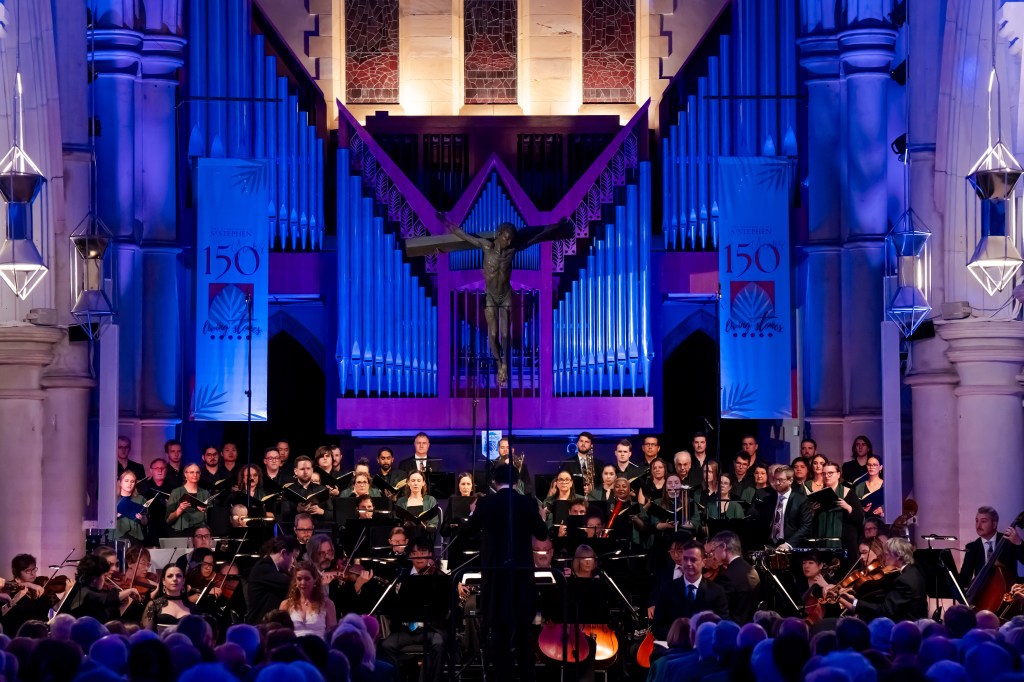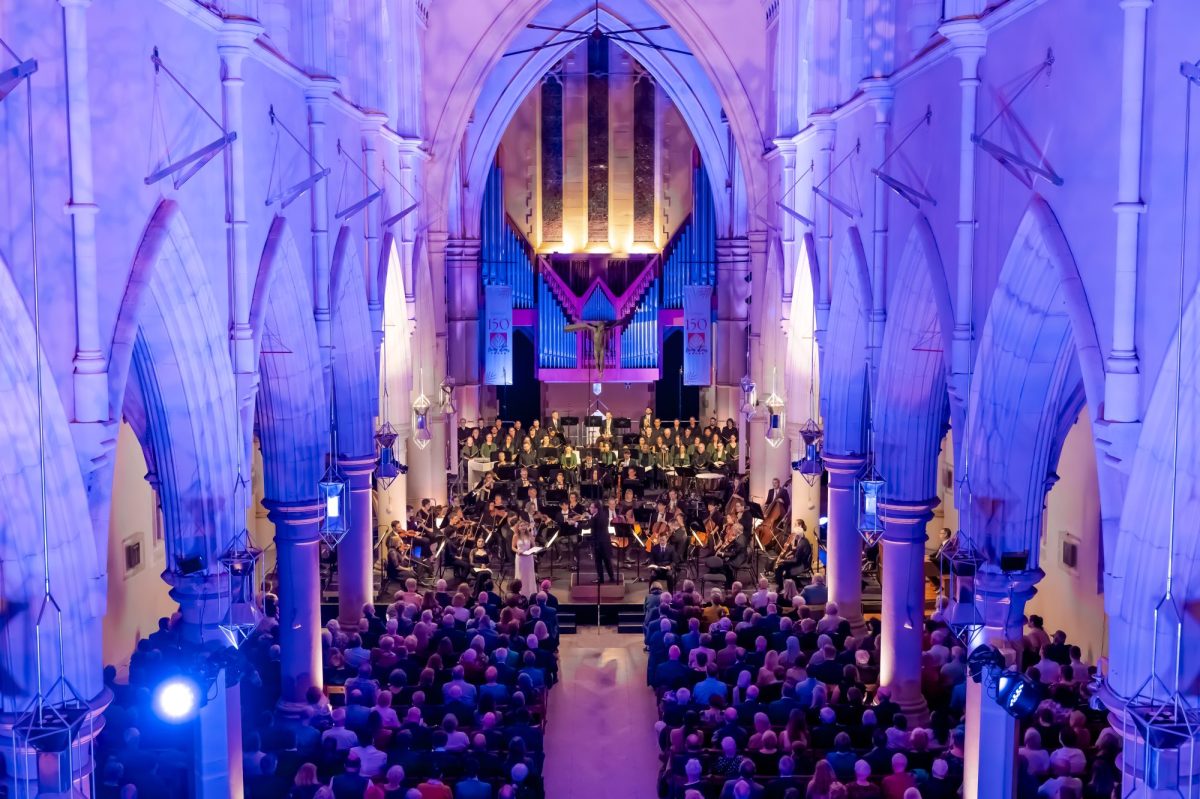One of the special events for Queensland Symphony Orchestra (QSO) in 2024, is a partnership created with the Cathedral of St Stephen in Brisbane, helping to celebrate its sesquicentenary. Performing religious music in an impressive ecclesiastical building involving a full orchestra, soloists and two choirs, is also a rare event. The three performances offered were all sold out well in advance.
There is possibly no greater work that could have been chosen by orchestra and cathedral alike than Mozart’s transcendent work, the mighty Mass in C Minor. Moreover, as the Archbishop of Brisbane, Mark Coleridge, pointed out in his introduction, the music of Mozart was heard at the cathedral’s opening in 1874, thus offering a nice symmetry with the 2024 celebration.
The concert commenced with a little known but quite delightful short liturgical work by French composer Lili Boulanger, a setting of Psalm 24, The Earth is the Lord’s. This work displays a majestic opening on organ, played confidently by the cathedral’s organist, Dominic Perissinotto, with bright trumpet fanfares and powerful choral singing. A light tenor solo from the Cathedral Schola rose ethereally as the work slipped into a gentle rhythmic rise and fall. In melodic unison, the uplifting choral chanting that followed led to a tremendous finale of ringing brass, organ and percussion.
Mozart’s Mass in C Minor, left unfinished at his death, was presented here in a complete and reconstructed version with all 13 movements in an arrangement by Franz Beyer. It flowed extremely well.
Commencing with gentle orchestral chords, the Kyrie developed into rich, fulsome orchestration; the addition of soprano Sara Macliver’s high soaring top notes perfectly suited to the venue. She has an enormous role in this Mass, but proved less adept in her lower register, seemingly breathless at times. The short Gloria offered huge choral passages leading to the Laudamus te where soprano, Sofia Troncoso, shone; her rich, dark voice and warm top offering a suitably different timbre to Macliver. Both sopranos came together in the Domine Deus, their contrasting vocals marvellously harmonic.
Qui Tollis offered exceptional choral singing by the higher female voices, accompanied by fierce violin bowings. Quoniam introduced Andrew Goodwin’s strong, luscious tenor alongside both sopranos, with a delightful blend of vocals and corresponding arpeggios. The powerfully rendered Jesu Christe from orchestra and chorus brought out delicious musical colours, while the Credo gave us first-rate string playing led by a solo from concertmaster, Kristian Winther.

Written by Mozart for his wife Constanze, Et incarnatus delivers one of Mozart’s brilliant soprano arias, which is as sublime as it is virtuosic. Macliver floated her voice high above the stave, in a powerful rendition, her lengthy sustained notes and numerous trills supported orchestrally. Summoning all her not inconsiderable vocal power and energy, she delivered a finely-crafted performance.
All four soloists are accomplished recital and concert singers; sopranos Macliver and Troncoso, tenor Goodwin and baritone David Greco, were expertly cast. Collectively their voices blended beautifully together in the final Benedictus and Agnus Dei movements, with some moving short solos from tenor and baritone in particular. Based on the vocal power of these fine movements, it is a pity that Mozart did not complete this work or compose more music for the two male voices.
The Brisbane Chamber Choir together with an enhanced St Stephen’s Cathedral Schola gave us an excellent and well-delivered joint chorale of more than 40 voices. The Mass is chorally challenging with a huge and complex workload musically. However, the many harmonic sections in various configurations were impressively managed. Musically, each choral section was exemplary and, despite a physical lack of space, the acoustic helped to deliver a rousing and fulsome sonority.
Orchestrally space was at a premium too. The violins spilled out into the left aisle and double basses into the right aisle of the nave, with brass squeezed at the far back under the organ. Nevertheless, the orchestra played with much passion and commitment. They were helped by a marvellous live acoustic that allowed the sound to reverberate, being carried into the vaulted roof and around the building. Atmospheric lighting in differing shades of yellow and purple gave the cathedral a warm and engaging ambiance.
The church setting also created a wonderful atmosphere for this music, the addition of the organ lending further gravitas to the majestic musical sections alongside brass and percussion. Special mention should be made of the fine woodwind playing from flute, oboe and bassoon in particular, which accompanied the soprano solo in the Et incarnatus movement of the Mass.
Chief Conductor of QSO, Umberto Clerici, is now in his second year of leading the Queensland Orchestra following a rapid career move from being a virtuosic cellist to taking up the baton. With his meteoric rise as a conductor, his assurance on the podium seems to increase with each concert. Technically proficient, his attention to detail plus his emotional investment in each piece of music he conducts is first-rate.
Read: Musical review: Black Box, Cremorne Theatre, QPAC
In particular, his interpretation of Mozart’s Mass showed a complete understanding of the work, bringing out the various musical colours in his palette of sounds. With compassion, flair and great skill, he managed the limited space for his musicians, including cueing his soloists to the front of the podium. Above all his musicianship displayed the joy and power of this momentous work. A terrific performance.
Queensland Symphony Orchestra
In association with the Cathedral of St Stephen presented
Mozart’s Mass
Conductor: Umberto Clerici
Musicians: Sara Macliver, Sofia Tronscoso, Andrew Goodwin, David Greco
Brisbane Chamber Choir
St Stephen’s Cathedral Schola
Mozart’s Mass was performed at Cathedral of St Stephen in Brisbane, 10-11 May 2024.





